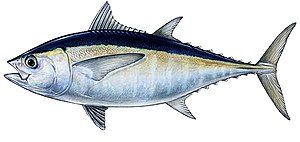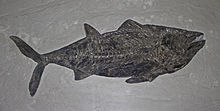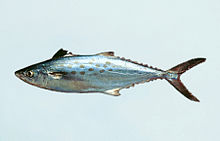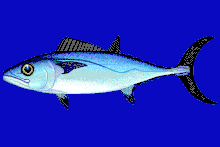Mackerel and tuna
| Mackerel and tuna | ||||||||||||
|---|---|---|---|---|---|---|---|---|---|---|---|---|

Blackfin Tuna ( Thunnus atlanticus ) |
||||||||||||
| Systematics | ||||||||||||
|
||||||||||||
| Scientific name | ||||||||||||
| Scombridae | ||||||||||||
| Rafinesque , 1815 |
The mackerel and tuna (Scombridae) are a family of marine fish found worldwide in all temperate, subtropical and tropical oceans. They are of great importance to the fishing industry.
features
The different species reach a size of approx. 20 centimeters up to 4.58 meters (this record size was measured in a bluefin tuna ). The females of many species grow larger than the male. The body of the mackerel and tuna is elongated and spindle-shaped, with some species somewhat flattened on the sides. Mackerel species have either no or only small cycloid scales (medium-sized in Gasterochisma ) and 31 to 64 vertebrae. In some species, the region behind the head and around the pectoral fins is covered by a corset of large, thick scales, the rest of the body is scaly or is only covered by small scales.
The fish have two dorsal fins, both of which can be placed in a groove on the back. The first dorsal fin, which is positioned well behind the head, is supported by 9 to 27 hard rays. The second is widely separated from the first. Between the dorsal and caudal fin, or the anal and caudal fin, there are five to twelve small flippers that help prevent the formation of eddies when swimming quickly. The caudal fin stalk is slender and has two bony keels on each side, and in the more advanced taxa it also has an enlarged keel. The caudal fin is deeply split or sickle-shaped. The caudal fin rays completely cover the hypuralia . The pectoral fins are set high on the body, the pelvic fins, which are located below the pectoral fins, are supported by six fin rays. The snout is pointed and cannot be turned forward (not protractile). The beak-shaped premaxillary is separated from the nasal by the ethmoid bone and firmly connected to the maxillary . The mouth extends behind the eyes. The teeth are pointy and vary in size and strength in different species. The palatine and tongue can also be dentate. The eyes have fat eyelids , and a ring of bone surrounds the back of the eye socket. The gill membranes have not grown together on the isthmus . The swim bladder is missing or small. Some species therefore have a greater density than the water and must avoid sinking through continuous swimming. The sideline is easy. Mackerel and tuna are usually bluish or greenish on the back, the flanks and the belly are whitish or silvery, often with black lines or waves.
Some tunas and bonitos, the genera Auxis , Euthynnus , Katsuwonus and Thunnus (Thunnini tribe), have a body temperature that is several degrees higher than the surrounding water temperature: blood vessels of the trunk muscles, arranged in a countercurrent principle , make this possible. Likewise, in these more highly evolved Scombrids, the gills are usually fused together to form a sieve, so that they are no longer individually movable (congestive breathing).
Way of life
Mackerel and tuna are predatory fish of the open ocean and can reach high speeds when hunting. The mackerel iwS (Scombrini, Scomber & Rastrelliger ) filter plankton out of the water with their long gill pots . Spanish mackerel ( Scomberomorus ), bonitos, and tuna feed on larger prey, including smaller fish, crustaceans, and squids . The smaller mackerel are mainly hunted by the larger tuna. Eggs and fry are pelagic (but close to the coast).
Internal system
The mackerel and tuna are divided into two subfamilies according to the size of the scales . The subfamily Gasterochismatinae only contains the large scale mackerel and is therefore monotypical . In the subfamily Scombrinae, the closely related genera are grouped into four tribes , of which only the monophyly of Scombrini is also supported by molecular genetic data. There are a total of 50 species in 15 genera :
- Subfamily Gasterochismatinae, medium-sized scales.
- Genus Gasterochisma
- Mackerel ( Gasterochisma melampus ) Richardson , 1845 .
- Genus Gasterochisma
- Subfamily Scombrinae, tiny scales or scaly.
- Scombrini tribe
- Genus Rastrelliger
- Rastrelliger brachysoma ( Bleeker , 1851) .
- Rastrelliger faughni Matsui, 1967 .
- Indian mackerel ( Rastrelliger kanagurta ) ( Cuvier , 1816) .
- Genus Scomber
- Scomber australasicus Cuvier, 1832 .
- Tuna mackerel ( Scomber colias ) Gmelin, 1789 .
- Scomber indicus Abdussamad et al., 2016 .
- Japanese mackerel ( Scomber japonicus ) Houttuyn, 1782 .
- Mackerel ( Scomber scombrus ) Linnaeus , 1758 .
- Genus Rastrelliger
- Tribe Scomberomorini
- Acanthocybium genus
- Wahoo ( Acanthocybium solandri ) (Cuvier, 1832) .
- Genus Grammatorcynus
- Grammatorcynus bicarinatus ( Quoy & Gaimard , 1825) .
- Two-line mackerel ( Grammatorcynus bilineatus ) ( Rüppell , 1836) .
- Genus Scomberomorus
- Scomberomorus brasiliensis Collette, Russo & Zavala-Camin, 1978 .
- Scomberomorus cavalla (Cuvier, 1829) .
- Torpedo mackerel ( Scomberomorus commerson ) ( Lacépède , 1800) .
- Scomberomorus concolor (Lockington, 1879) .
- Scomberomorus guttatus ( Bloch & Schneider , 1801) .
- Scomberomorus koreanus (Kishinouye, 1915) .
- Scomberomorus lineolatus (Cuvier, 1829) .
- Scomberomorus maculatus (Couch, 1832) .
- Scomberomorus multiradiatus Munro, 1964 .
- Scomberomorus munroi Collette & Russo, 1980 .
- Scomberomorus niphonius (Cuvier, 1832) .
- Scomberomorus plurilineatus Fourmanoir, 1966 .
- Scomberomorus queenslandicus Munro, 1943 .
- King mackerel ( Scomberomorus regalis ) (Bloch, 1793) .
- Scomberomorus semifasciatus (Macleay, 1883) .
- Scomberomorus sierra Jordan & Starks, 1895 .
- Scomberomorus sinensis ( Lacépède , 1800) .
- Scomberomorus tritor ( Cuvier , 1832) .
- Acanthocybium genus
- Tribe Sardini
- Genus Cybiosarda
- Genus Gymnosarda
- Monochrome tuna ( Gymnosarda unicolor ) (Whitley, 1935) .
- Genus Orcynopsis
- Unstriped pelamid ( Orcynopsis unicolor ) ( Geoffroy Saint-Hilaire , 1817) .
- Genus Sarda
- Australian bonito ( Sarda australis ) (Macleay, 1881) .
- Pacific bonito ( Sarda chiliensis ) (Cuvier, 1832) .
- Oriental bonito ( Sarda orientalis ) ( Temminck & Schlegel , 1844) .
- Pelamide ( Sarda sarda ) (Bloch, 1793) .
- Tribe Thunnini
- Genus Allothunnus
- Schlankthun ( Allothunnus fallai ) Serventy, 1948 .
- Genus auxis
- Auxis rochei ( Rafinesque , 1810)
- Loggerhead bonito ( Auxis thazard ) Lacepède , 1800
- Genus Euthynnus
- Euthynnus affinis ( Cantor , 1849) .
- Thonine ( Euthynnus alletteratus ) ( Rafinesque , 1810) .
- Black skipjack ( Euthynnus lineatus ) Kishinouye, 1920 .
- Genus Katsuwonus
- True bonito ( Katsuwonus pelamis ) ( Linnaeus , 1758) .
- Genus tuna ( Thunnus )
- Albacore tuna ( Thunnus alalunga ) ( Bonnaterre , 1788) .
- Yellowfin tuna ( Thunnus albacares ) (Bonnaterre, 1788) .
- Blackfin tuna ( Thunnus atlanticus ) ( Lesson , 1831) .
- Bigeye tuna ( Thunnus obesus ) (Lowe, 1839) .
- South Atlantic bluefin tuna ( Thunnus maccoyii ) ( Castelnau , 1872) .
- Pacific bluefin tuna ( Thunnus orientalis ) ( Temminck & Schlegel , 1844) .
- Long-tailed tuna ( Thunnus tonggol ) ( Bleeker , 1851) .
- Bluefin tuna ( Thunnus thynnus ) (Linnaeus, 1758) .
- Genus Allothunnus
- Scombrini tribe
Tribal history

Some recent genera of mackerel and tuna, such as Auxis , Scomber and Thunnus , have been found in fossils since the Eocene , and Sarda and Scomberomorus even since the Paleocene . Grammatorcynus has been known since the Oligocene . Godsilia , Isurichthys , Palimphyes , Scombrodarda , Turio and Xiphopterus are extinct genera from the Oligocene, Eocene and Miocene

literature
- Bruce B. Collette, Cornelia E. Nauen: Scombrids of the world. An annotated and illustrated catalog of tunas, mackerels, bonitos and related species known to date (= FAO Species Catalog. Vol. 2 = FAO Fisheries Synopsis. No. 125, Vol. 2). United Nations Development Program et al., Rome 1983, ISBN 92-5-101381-0 , ( complete edition ).
- Kurt Fiedler: Fish (= textbook of special zoology. Vol. 2: Vertebrates. Part. 2). Gustav Fischer, Jena 1991, ISBN 3-334-00338-8 .
- Joseph S. Nelson : Fishes of the World. 4th edition. John Wiley & Sons, Hoboken NJ et al. 2006, ISBN 0-471-25031-7 .
Web links
- Mackerel and tuna on Fishbase.org (English)
Individual evidence
- ^ Karl Albert Frickhinger: Fossil Atlas of Fishes. Mergus - Verlag für Natur- und Heimtierkunde Baensch, Melle 1991, ISBN 3-88244-018-X .









